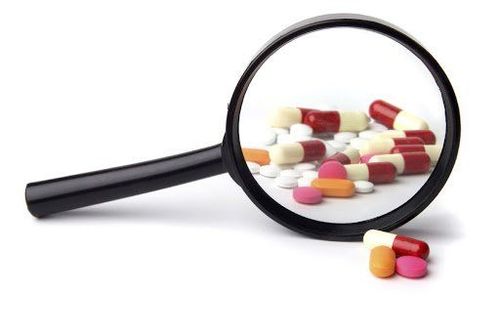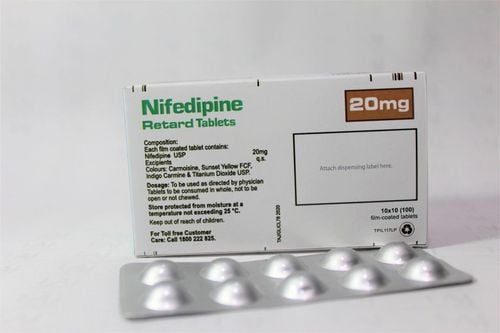This is an automatically translated article.
Nicardipine is a familiar drug for people with high blood pressure, stroke or kidney problems. So what is the process of using Nicardipine and what is the recommended dose for each patient? All important information about the drug will be answered below.
1. What are the uses of Nicardipine?
What is Nicardipine? Nicardipine is used alone or in combination with other drugs to treat high blood pressure, thereby helping people prevent strokes, heart attacks, and kidney problems. Nicardipine is a calcium channel blocker that works by dilating blood vessels and allowing blood to flow more easily. Therefore, the drug is also often prescribed for people who are suffering from angina pectoris. During the use of the drug reduces the frequency of angina attacks slowly but extremely effectively.
2. How should Nicardipine be used to achieve high efficiency in treatment?
According to the advice from the manufacturer and the doctors, the patient should take the drug 3 times a day, it can be taken with or without food or as needed by a professional doctor. Because your doctor will divide the dose based on your medical condition and response to treatment.
During the time of taking Nicardipine, the patient needs to take it regularly, at the same time every day and strictly follow the advice that the doctor has advised you. If during use, you notice that your body has abnormal symptoms, you should contact your doctor to discuss whether to continue taking the drug or stop.
2.1 Adult dosing for high blood pressure Immediate-release oral form:
Initial dose: 20 mg orally 3 times a day; Maintenance dose: 20-40 mg orally 3 times a day. Extended-release oral form:
Initial dose: 30 mg orally 2 times a day; Maintenance dose: 30-60 mg orally 2 times a day. In addition to oral tablets, patients are also advised by doctors for intravenous infusion in some cases. The intravenous infusion rate required to produce mean plasma concentrations, corresponding to oral doses at steady state:
20 mg orally every 8 hours is approximately 0.5 mg/hour by intravenous infusion IV;30 mg orally every 8 hours approximately 1.2 mg/hour by intravenous infusion; Oral 40 mg every 8 hours approximates 2.2 mg/hour by intravenous infusion. For the starting dose, patients received an intravenous infusion of 5 mg/hour. The infusion rate may be increased to 2.5 mg/hr every 5 to 15 minutes and to a maximum of 15 mg/hr, until the desired blood pressure level is achieved.
Intravenous infusion should be done under the supervision of doctors, medical staff to ensure the best effect.
2.2 Dosage for angina pectoris Immediate-release oral form:
Initial dose: 20 mg orally 3 times a day; Maintenance dose: 20-40 mg orally 3 times a day. Extended-release oral form:
Initial dose: 30 mg orally 2 times a day; Maintenance dose: 30-60 mg orally 2 times a day. Unlike patients with hypertension, the intravenous dose for patients with angina pectoris is adjusted as follows:
20 mg orally every 8 hours is approximately 0.5 mg/hour by intravenous infusion Take 30 mg every 8 hours approx. 1.2 mg/hr by IV infusion 40 mg every 8 hrs approx. 2.2 mg/hr by IV infusion Not much information is available on the dosing of nicardipine for children. Therefore, if you intend to use it for young children, you need to consult your doctor for appropriate indications. It is strictly forbidden to arbitrarily buy drugs for children, because this has many potential risks that seriously affect the health of the baby.
3. Important notes when taking Nicardipine
The information to note when taking the drug is also an important issue that patients need to pay attention to when using. Because this will directly affect the treatment process and the patient's health.
Rash, difficulty breathing, swelling of the face, lips, and tongue are side effects of the drug, so when experiencing the above symptoms, the patient should contact a doctor. If you have heart, liver, or kidney disease, talk to your doctor before deciding to take this medicine. List all prescription and non-prescription medications you are taking so that your doctor can adjust the dose. accordingly. Pregnant and lactating women should not take the drug unless directed by a medical professional. If you notice any unusual signs, the patient should contact the doctor for advice. Above is all the important information about Nicardipine. Knowing the important issues before taking the drug along with the notes will help the process of use achieve good results in treatment as well as minimize the unwanted effects.
Please dial HOTLINE for more information or register for an appointment HERE. Download MyVinmec app to make appointments faster and to manage your bookings easily.













